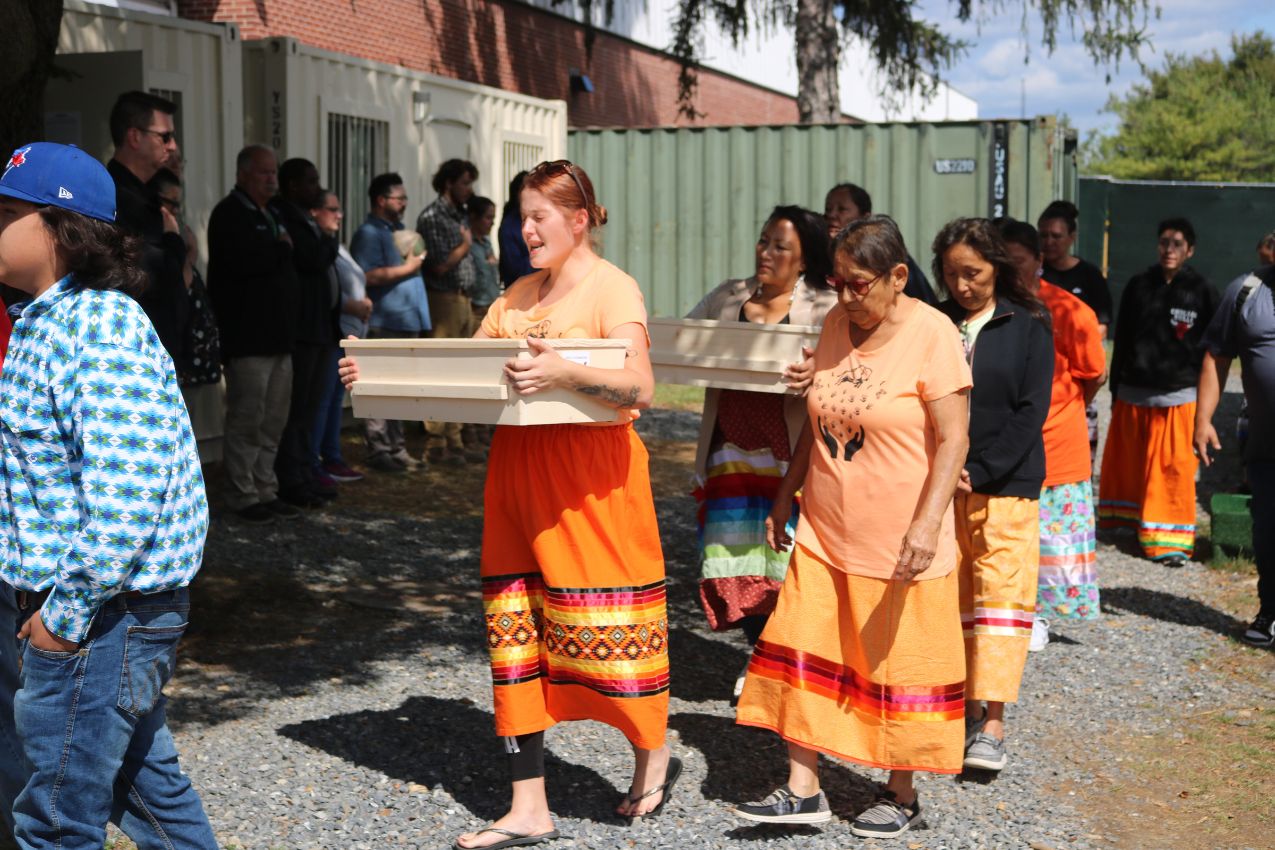
- Details
- By Jenna Kunze
The remains of 11 Native American children who died more than a century ago at a government-run Indian boarding school in Pennsylvania will be going home to their closest living relatives this September, the U.S. Office of Army Cemeteries announced in a federal notice on April 9.
Those former students include William Norkok from the Eastern Shoshone Tribe; Almeda Heavy Hair, Bishop L. Shield, and John Bull from the Gros Ventre Tribe of the Fort Belknap Indian Community; Fanny Chargingshield, James Cornman, and Samuel Flying Horse from the Oglala Sioux Tribe; Leonidas Chawa from the Pechanga Band of Indians; Albert Mekko from the Seminole Nation of Oklahoma; and Alfred Charko and Kati Rosskidwits from the Wichita and Affiliated Tribes.
The students are among nearly 200 who died and were buried in the government’s care between 1880 and 1910 while attending the nation’s flagship Indian boarding school, Carlisle Indian Industrial School, in Carlisle, Penn.
In 1879, the Army’s Carlisle Barracks became the site of the nation’s first government-run Indian boarding school. Operating under the motto of “kill the Indian, save the man,” school administrators tried to forcibly assimilate 7,800 Native American children from more than 140 tribal nations through a mix of Western-style education and hard labor.
Before it closed and the property was transferred to the Army in 1918, the school buried the bodies of at least 194 Indigenous children in the school cemetery, including 14 who are marked with “unknown” grave markers.
Many students’ deaths were announced in the local newspaper at the time, noting causes of death as “that dread disease, consumption” or tuberculosis, or detailing circumstances of unknown sickness.
Alfred Charko, who died at 15 just five months after arriving at Carlisle from his home in Kansas, “was sick before he came, so he was in the hospital ever since he came” [to Carlisle], according to a student newspaper at the time.
Fanny Chargingshiled died 13 months after arriving at Carlisle from South Dakota at 16. According to the school paper, Fanny’s father Chief Chargingshield, traveled to Pennsylvania to visit his sick daughter. But it’s unclear if he reached her before she died, or why he didn’t bring home her remains at that time for reburial.
In a response to NNO on April 12, Office of Army Cemeteries spokesperson Olivia Van Den Heuvel said that " the Army is working to establish a process to support efforts to identify the unknown individuals and return them to their families." She did not specify a timeframe.
Most of the children’s fates were acknowledged by a single word in their records, written in red script in the top right corner: dead.
The disinterment of the 11 Native students’ remains is scheduled to begin on September 3, 2024, and end on October 14, according to the Office of Army Cemeteries.
Over the last seven years, the Army has returned 32 children’s remains back to their relatives. Each project has been conducted over about a month-long period during the summer by a team of professionals from the Army Corps of Engineers’ Center of Expertise for Curation. The team worked with tribal nations to carry out the process of exhuming and identifying each child’s remains. The Army confirmed to NNO that it will be disinterring and returning an additional 18 children in 2025.
“It’s special, but it’s hard,” Emma Filestell, the Fort Belknap Tribe’s deputy tribal historic preservation officer, told Native News Online about her tribe’s upcoming returns. Filestel traveled with a tribal delegation from Montana to Carlisle in September 2023 to initiate the process of return for their ancestors. “It’s going to be good to have them home,” she said.
Overall, negotiating the return of their ancestors with the Office of Army Cemeteries has been relatively smooth for her tribe, Filestell said. This marks a significant departure from a process previous tribes have criticized as culturally “tone deaf.”
“After all the [other] tribes that fought for this before us, there’s actually no barriers up for us,” Filestell said. She said that everything Fort Belknap has asked the Army for, including specific ceremonial protocols, and vehicles to caravan back to Montana with after the disinterment, the Army has agreed to, without hesitation. “It’s making it easier for us,” she said.
The Fort Belknap delegation requested the return of four relatives, but only three will be returned this year.
The fourth ancestor, Solomon Brown, won’t be coming home in September. That’s because Brown is one of the children buried under a headstone marked “Unknown”, the result of apparent mismanagement of the cemetery over the decades. That includes 1927, when the U.S. Army dug up the remains of Carlisle’s Indian children and moved their graves to an area next to the barracks entrance to make room for development.
The Army told the Fort Belknap delegation they’ll have to wait until the exhumation process is nearly complete for the remaining more than 160 relatives buried at the Carlisle Barracks Main Post Cemetery before they intend to exhume the “Unknowns.” At the Army’s current rate of exhuming and returning about seven to ten ancestors per year, that could mean another decade and a half of waiting.
“The only thing is the unknowns,” Filestell added. “One of our issues with that is having to go back a second time [for Solomon.]”
The Cheyenne and Arapaho Tribes of Concho, Okla. also visited Carlisle in September 2023 to prepare to bring home 15 relatives—including one unknown—but won’t be repatriating them until 2025. Because the tribe didn’t file its paperwork with the Army until around February, the schedule was already full, Cheyenne and Arapaho tribal historic preservation officer Max Bear told Native News Online.
“It got pushed back a little further, which just gives us an opportunity to prepare,” Bear said, adding that his tribe still needs to establish a repatriation cemetery for reburial.
In a response to Native News on April 12, Office of Army Cemeteries spokesperson Olivia Van Den Heuvel said “the Army is working to establish a process to support efforts to identify the unknown individuals and return them to their families.” She did not specify a timeframe.
Some tribal nations say that tribes—including Fort Belknap and Cheyenne and Arapaho—should not have to go back a second time to collect their relatives who were forcibly removed from their communities. They believe federal law backs up their beliefs.
In January 2024, The Winnebago Tribe of Nebraska filed a lawsuit against the United States Army, seeking the return of the remains of two of its children who died and were buried at Carlisle more than 120 years prior. The lawsuit alleges that the Army failed to follow federal law and instead used its own process, which is often lengthier, immune to tribal protocol, and defines who can request the return of a child buried at Carlisle (their “closest living relative”).
The Winnebago tribe argues that Congress enacted a law that should govern situations like this one: the Native American Graves Protection and Repatriation Act (NAGPRA). NAGPRA became law in 1990 to provide a process for federal agencies and museums that receive federal funds to repatriate or transfer certain Native American cultural items—including human remains—back to their respective tribal nations.
Winnebago Tribal Historic Preservation Office Sunshine Bear, who has been researching methods to bring her tribe's children home since 2021, said this lawsuit is about tribal sovereignty, and paving the way for other tribes to bring their children home on their own timeline, and with their own customs.
“I intend to follow this through,” Bear told Native News Online in the wake of the Army’s federal register notice on Wednesday. She said that her tribe expects a response from the Army by next week, within the 90-day time period required by law.
“All we want is our children to be returned home. But I also want [the Army] to follow the regulations and policies of NAGPRA,” she said. “I’m happy for Fort Belknap that they're bringing some of their children home, but by following the Army's process, they're not bringing all of them home. They still have to come back for one more because…of the Army’s policy.”
Editor's Note: This story has been updated with a response from the Office of Army Cemeteries about the number of children it plans to return in 2025 and its efforts to establish a process to identify the unknown individuals and return them to their families.
More Stories Like This
50 Years of Self-Determination: How a Landmark Act Empowered Tribal Sovereignty and Transformed Federal-Tribal RelationsTreasury Finalizes Tribal Tax Rules Ending Decades of Uncertainty
Finalized Tax Rules Seen as Historic Win for Tribal Economies
Cherokee Nation Launches Digital Dictionary to Support Language Revitalization
Prairie Band Potawatomi Nation Chairman Addresses Homeland Security Contract
Help us defend tribal sovereignty.
At Native News Online, our mission is rooted in telling the stories that strengthen sovereignty and uplift Indigenous voices — not just at year’s end, but every single day.
Because of your generosity last year, we were able to keep our reporters on the ground in tribal communities, at national gatherings and in the halls of Congress — covering the issues that matter most to Indian Country: sovereignty, culture, education, health and economic opportunity.
That support sustained us through a tough year in 2025. Now, as we look to the year ahead, we need your help right now to ensure warrior journalism remains strong — reporting that defends tribal sovereignty, amplifies Native truth, and holds power accountable.
 The stakes couldn't be higher. Your support keeps Native voices heard, Native stories told and Native sovereignty defended.
The stakes couldn't be higher. Your support keeps Native voices heard, Native stories told and Native sovereignty defended.
Stand with Warrior Journalism today.
Levi Rickert (Potawatomi), Editor & Publisher


